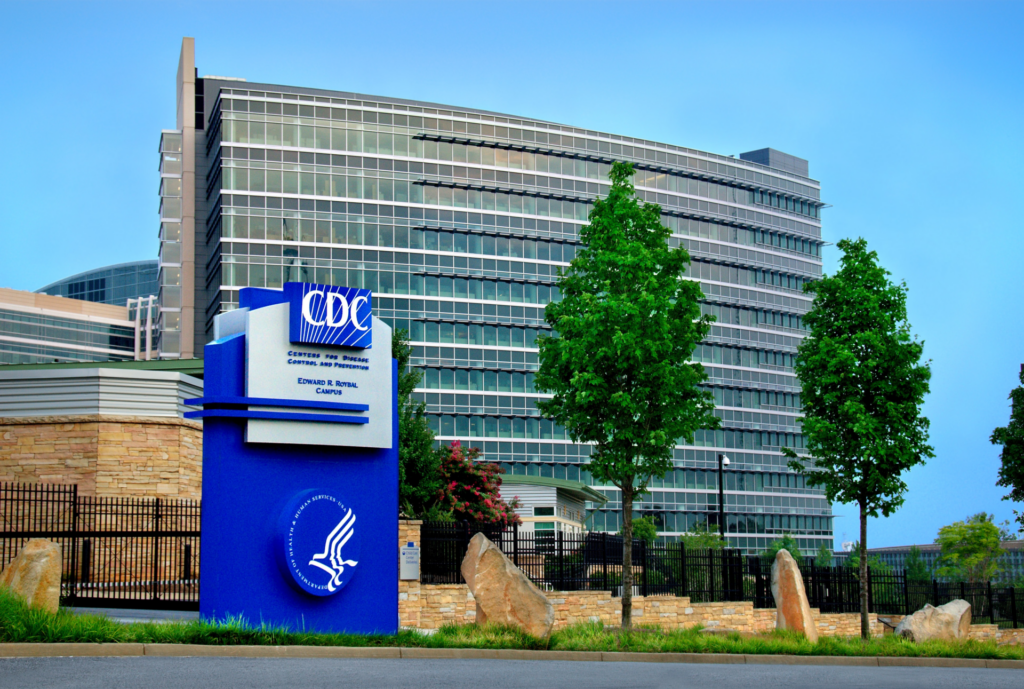Public health position available: Low pay. Promise of burnout and harassment. Master’s preferred.
By Kimberly Ma | September 1, 2023
 The Centers for Disease Control and Prevention (CDC). Credit: James Gathany/CDC via Wikimedia Commons.
The Centers for Disease Control and Prevention (CDC). Credit: James Gathany/CDC via Wikimedia Commons.
Will there be another pandemic after COVID? Considering that there have been at least four major international disease crises in the last 20 years alone—plus a number of smaller but still serious outbreaks—smart money would say, “yes.” But a look at trends in the US public health workforce, at first glance, suggests that government agencies have taken the opposite bet. The state and local health departments responsible for disease surveillance, vaccination campaigns, and assistance in natural disasters like wildfires or hurricanes are hemorrhaging workers, with an additional 130,000 at risk of leaving the profession by 2025. Unless something changes soon, there will be too few new employees to backfill empty positions—or to make up for the loss of invaluable institutional knowledge.
One key to solving the public health workforce problem lies in figuring out how to sell these jobs as plausible career paths. That’s not as straightforward a proposition as it may sound at first. Many workers left these jobs in recent years after experiencing burnout or harassment. In fact, one large survey found a third of US workers in the field reported intimidation or other forms of negative treatment during the pandemic. Seeing public health workers getting “doxxed”—having personal information revealed online—or receiving slur-ridden messages on social media certainly can leave a bad impression.
But an equally big problem in public health isn’t personal, it’s structural: Money for salaries is dwindling and not keeping up with the cost of living or with obtaining higher education qualifications.
Public health departments, like other organizations, prize job candidates with graduate degrees—especially from prestigious institutions. According to the US government, the percentage of 25- to 29-year-olds who got a master’s degree increased by more than 40 percent between 2010 and 2022. Master’s programs, however, often churn out graduates who may not be able to pay back high student loans (or cover the rent) on public health salaries.
Getting a public health master’s degrees from a “top 10” U.S. News-ranked graduate program in the United States can take years and cost over $100,000. At the same time, some entry level jobs, while requiring a master’s degree, have starting salaries of less than $60,000—including in major cities with high costs of living. Add in other factors, such as high inflation, and an overall bleak monetary picture for public health workers emerges. The reality is, without an infusion of consistent funding in the near future, public health agencies may not be able to offer salaries sufficient to pay the bills for new master’s graduates.
Lowering barriers to public health careers. Andrew Pickett, the director of emergency preparedness and response for the Pennsylvania Department of Health, put it to me this way: “[T]o obtain new talent, public health needs to make it easier and more cost-effective to become a public health employee.”
But the roles in a public health department are varied. Some do require high-level training—epidemiological analysis, for example—while others do not. The latter might include positions dealing with administrative management, data input, and office coordination, where candidates without graduate degrees or public health experience could likely do some of the work. In Pickett’s organization, many employees didn’t come from another public health department, but they did have useful experience in areas such as customer service. Pickett expects most new hires will require training anyway, so his priority, he said, is hiring “people who are willing to learn.” Perhaps more public health departments could do well by casting a recruitment net that extends beyond master’s programs and also captures graduates from a broader pool of bachelor’s, certificate, or community college programs, or even employees from other sectors. This would amount to hiring based on skillsets, rather than educational qualifications or program prestige.
Those unfamiliar with the public health funding structure may be puzzled by the whole premise of the issue. Why don’t public health departments simply provide more appropriate salaries? They would then be able to both hire bright young minds and keep existing staff, thereby growing the workforce instead of simply stanching losses.
In an ideal world, this is what would happen. But the current system of public health funding in the United States is simply not formulated to allow for this wonderful, simple solution, and historical precedents do not suggest systemic change is in the cards any time soon.
It is important to remember that Congressional decisions directly determine each year’s federal public health funds. Congressionally approved funds are distributed by the Centers for Disease Control and Prevention (CDC) to state and territorial health agencies, which then distribute money to local health departments as per each jurisdiction’s structure. However, history shows that public health writ large has been regularly subject to what is called the “boom and bust cycle,” in which funds come pouring in during or after an emergency, but then recede as the crisis becomes an afterthought. Overall, federal public health funding through the CDC has failed to keep pace with rising needs, and agencies are feeling squeezed as they struggle to serve the public at the same level but with fewer resources.
There are, of course, the emergency funds that Congress approves to help support public health in times of crisis, like the Infectious Disease Rapid Response Reserve Fund. While this is a big pot of funding, it also tends to have strict constraints on the eligible activities or items that it can go towards. Contracted staff aside, long-term hiring outside of the immediate infectious disease crisis in question is rarely allowed under these grants.
So the question is, while continuing to advocate for more funding for responding to disasters such as hurricanes, wildfires, or bioterrorist attacks, what can public health departments do in the meantime? In parallel with calling for greater and more sustained resources, they need to try to find workforce solutions right now, with an eye to current legal and administrative constraints.
For many departments, keeping current employees on the job may be as important as hiring new ones. A solution to stemming the outflow of workers will require looking beyond salaries and financial numbers and toward issues related to mental health and professional growth.
Mackenzie Raub, a former county public health agency staffer in Pennsylvania, told me that during her time supporting the COVID response, her department was in charge of running vaccination clinics. With an enormous pandemic workload, time, energy, and people were all stretched thin, she said.
Then came a flood of COVID relief funding, and her agency was able to hire a large group of new staff. The apparent good fortune, however, proved short-lived. First, distribution of the COVID vaccine made by Johnson & Johnson was paused, and shortly after that, the overwhelming surge in need for vaccination clinics subsided in May 2021. Some staff, Raub said, ended up “twiddling their thumbs.” For organizational reasons, it can be hard for senior employees to retrain staff for new tasks while continuing to plug away at a workload during a crisis. Unfortunately, without new fulfilling roles, many of Raub’s colleagues ended up leaving.
Raub’s story demonstrates one reason why new staff in public health may choose to leave the field not long after entering it, despite a continued belief in the mission. Many of those who complete graduate programs in public health are initially surprised by what they end up working on in the field. In Raub’s case, some of her agency’s new hires expected intensive community engagement—running clinics, giving shots, that sort of thing—but instead ended up having almost nothing to do in their scopes of work. While new staff join the field fresh out of school and raring to go, they may end up doing mainly paperwork. That paperwork, such as data entry or grants management, is hugely important, and there certainly is no dearth of it that needs doing—but this discrepancy between expectations and reality can exacerbate the sense of burnout and disconnect that workers may feel.
Veteran staffers like Raub and Pickett fully understand the disillusionment, and Raub herself ended up moving out of public health, taking a pay cut to do so. She felt burned out from responding to COVID, and despite a lower salary, the professional growth opportunities elsewhere were too good to pass up. The public health field will need to continue to adapt and find solutions to staff shortages through making public health an appealing career to stick with, perhaps even by working with educational programs to give students better expectations of what their future work may look like.
Change may mean exploring ways to help workers feel motivated, including by constantly re-emphasizing the connection between seemingly mundane work and public health’s life-saving impacts. A low(er)-hanging fruit may mean urging employers to look at candidates with different degrees, not just those with a master’s in public health diploma from a top-ranked university. It would also help for more agencies to be open to hiring people from different education backgrounds. As Raub aptly put it, “[Public health] is such a diverse field, why should we not have a diverse workforce?”
One weakness of the 2022 National Biodefense Strategy—the US government blueprint for mitigating the risks of biothreats like zoonotic spillover or bioterrorism—was that it didn’t adequately describe the gutted state of the public health workforce—the same workforce that would be called on in future infectious disease crises. With the risk of another pandemic real and rising, it’s time to draw attention to the disappearing public health worker.
Together, we make the world safer.
The Bulletin elevates expert voices above the noise. But as an independent nonprofit organization, our operations depend on the support of readers like you. Help us continue to deliver quality journalism that holds leaders accountable. Your support of our work at any level is important. In return, we promise our coverage will be understandable, influential, vigilant, solution-oriented, and fair-minded. Together we can make a difference.
Keywords: public health
Topics: Biosecurity
















Kimberly, great article outlining the current challenges the Public Health department is facing. The reality is that all systems are run by individuals from a different era, when serious issues were swept under the rug and left for the next generations to deal with. Decisions are always viewed from a monetary perspective and are never beneficial for the population or the employees. Preventive work receives minimal attention in favor of situations where pharmaceutical companies profit. Guess who benefits from the financial fallout? We will continue to spin our wheels to make a difference in our communities unless the old guard… Read more »
Kim, I agree with you that for some reason our govt. refuses to see the importance of real investment into our healthcare system..